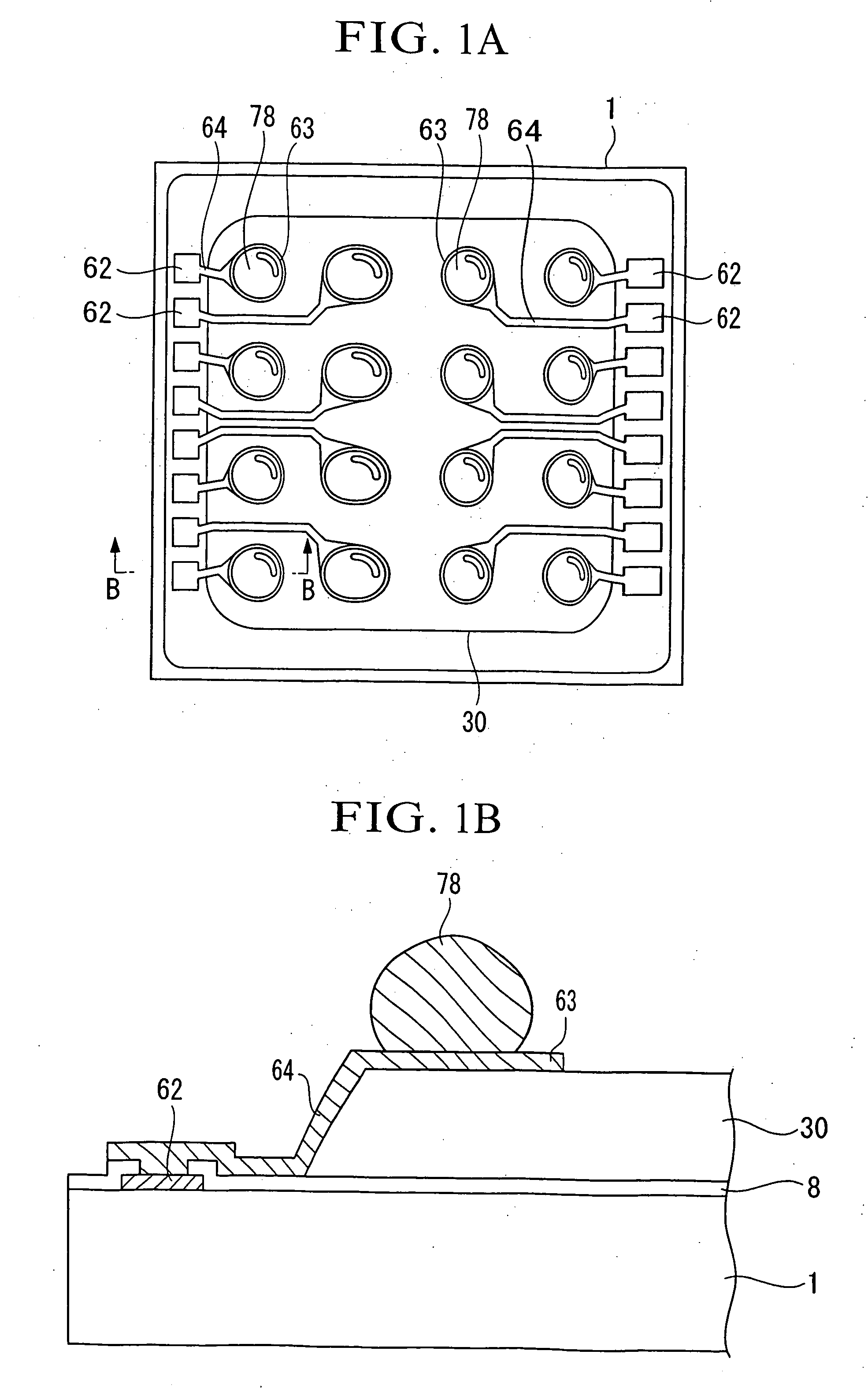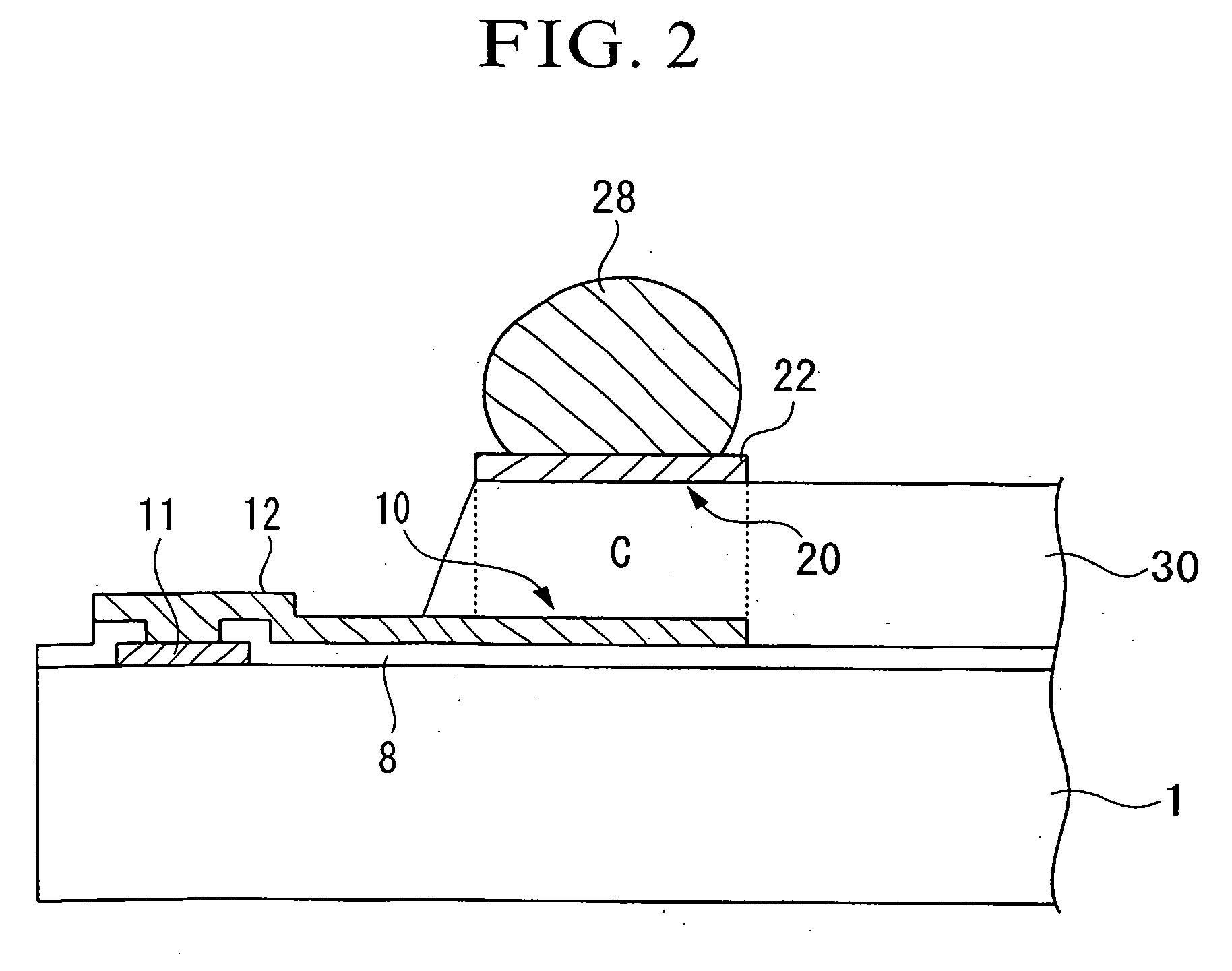Electronic board, method of manufacturing the same, and electronic device
- Summary
- Abstract
- Description
- Claims
- Application Information
AI Technical Summary
Benefits of technology
Problems solved by technology
Method used
Image
Examples
first embodiment
[0037] The semiconductor chip (electronic board) according to the present embodiment is one in which a stress-relaxation layer is formed on the surface of a semiconductor chip having an electronic circuit formed thereon, with rearrangement wiring for connection terminals of the electronic circuit formed on the surface of the stress-relaxation layer. The rearrangement wiring for the connection terminals and the stress-relaxation layer shall be initially explained.
[0038] Rearrangement Wiring
[0039]FIG. 1A and FIG. 1B are explanatory drawings of the rearrangement wiring, with FIG. 1A being a plan view of the semiconductor chip, and FIG. 1B being a side sectional view of the rearrangement wiring along line B-B in FIG. 1A. As shown in FIG. 1B, a passivation film 8 for protecting the electronic circuit is formed on the surface of the semiconductor chip on which the electronic circuit is formed. A connection terminal 62 for external electrical connection of the electronic circuit is forme...
second embodiment
[0067]FIG. 4A is a side-view sectional view of the semiconductor chip according to the second embodiment. In the second embodiment, the connection terminal 11 functions as the first electrode 10 of the capacitor C, thereby differing from the first embodiment in which the first layer wiring extended from the connection terminal functions as the first electrode. Detailed explanations for those constituent elements similar to the first embodiment shall be omitted.
[0068] In the second embodiment, the stress-relaxation layer 30 is formed so as to cover the connection terminal 11. For that reason, a portion of the stress-relaxation layer 30 is either extended to the edge part of the surface of the semiconductor chip 1, or the connection terminal 11 is formed in advance toward the center portion of the semiconductor chip 1. The second layer wiring 22 is formed on the surface of the stress-relaxation layer 30 in the similar manner as in the first embodiment.
[0069] The capacitor C is forme...
third embodiment
[0073]FIG. 5A is a side sectional view of the semiconductor chip according to the third embodiment. While in the first embodiment the capacitor C is formed by using a single stress-relaxation layer in the dielectric layer, the third embodiment differs on the point the capacitor C being formed by using a plurality of stress-relaxation layers in the dielectric layer. Detailed explanations for those constituent elements similar to the first embodiment shall be omitted.
[0074] In the third embodiment, a first stress-relaxation layer 31 is formed in the center portion of the surface of the semiconductor chip 1, and a second stress-relaxation layer 32 is formed on the surface of the first stress-relaxation layer 31. The first layer wiring 12 is formed at the back side of the first stress-relaxation layer 31, and the second layer wiring 22 is formed on the surface of the second stress-relaxation layer 32.
[0075] The capacitor C is formed in the region where in the plan view the first layer...
PUM
 Login to View More
Login to View More Abstract
Description
Claims
Application Information
 Login to View More
Login to View More - R&D
- Intellectual Property
- Life Sciences
- Materials
- Tech Scout
- Unparalleled Data Quality
- Higher Quality Content
- 60% Fewer Hallucinations
Browse by: Latest US Patents, China's latest patents, Technical Efficacy Thesaurus, Application Domain, Technology Topic, Popular Technical Reports.
© 2025 PatSnap. All rights reserved.Legal|Privacy policy|Modern Slavery Act Transparency Statement|Sitemap|About US| Contact US: help@patsnap.com



